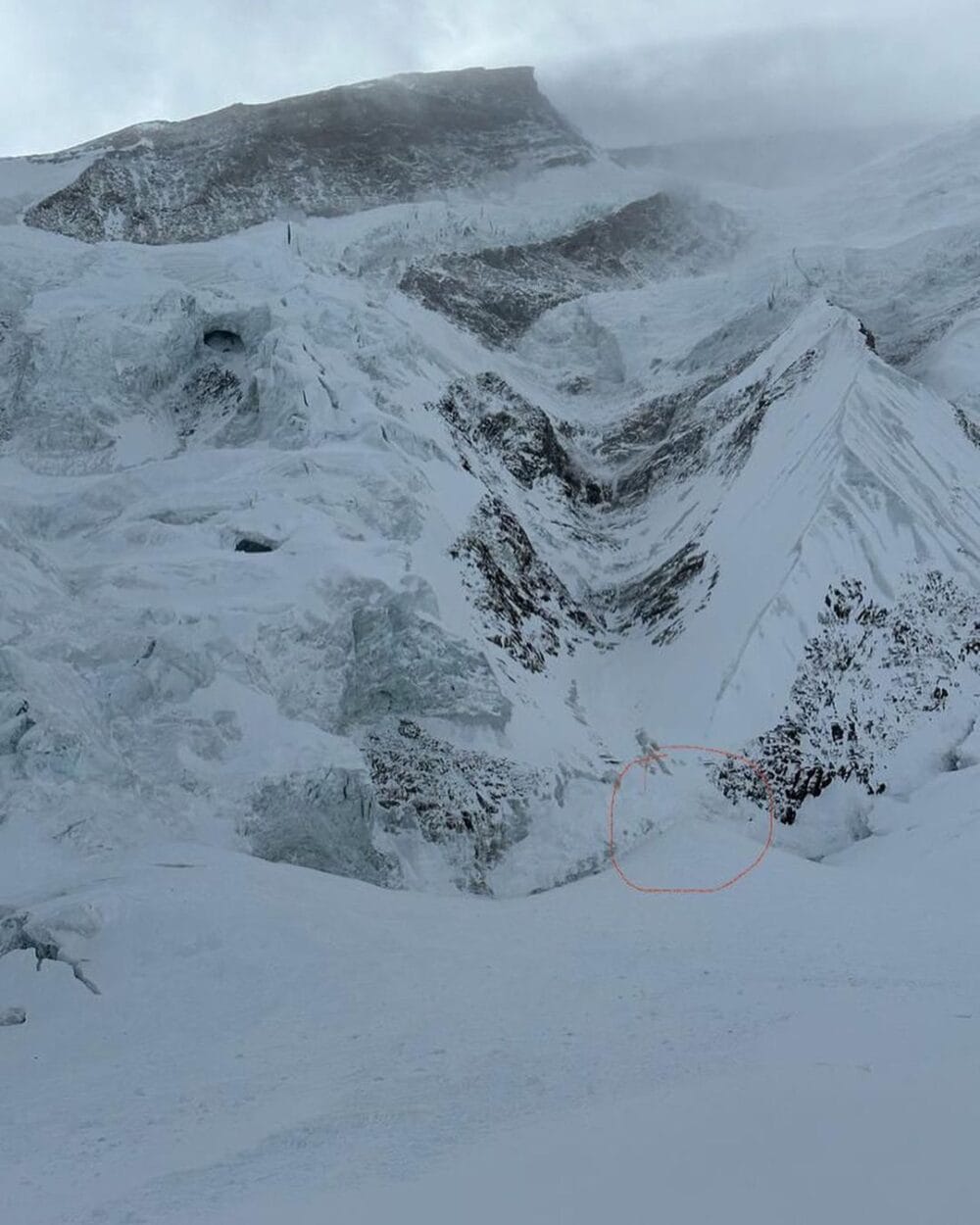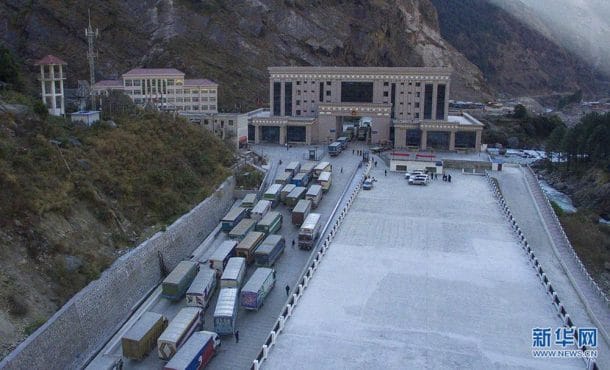While teams are as high as Camp 2 on Everest, most of the attention was on Annapurna, where one climber died, and two other climbers were miraculously rescued. Heavy snow hit Everest, but climbing continued. Everest Base Camp is filling up as permits topped 400, a record for the Nepal side. The fixed rope was set to the South Col. I expect it reaches the summit late next week.
Last Week
Annapurna Death
Noel Hanna, 56, died in his tent at Camp 4 at 23,300 feet on Tuesday, April 18, 2023, after summiting without supplemental oxygen. His sister, Irene, told the BBC that her brother had called, saying he was not feeling well. His body was recovered and flown to Kathmandu. The Irish climber was an experienced mountain guide and had summited Everest ten times plus K2 in 2019. My sincere condolences to their families, friends, and teammates.
Annapurna Rescue
Anurag Maloo, 34, fell into a crevasse three days before being found barely alive by rescuers. Polish climbers Adam Bielecki, and Mariusz Hatala were on a different side of Annapurna attempting a new route. They had practically given up because of poor climbing conditions when Seven Summits Treks founder Chhang Dawa Sherpa, knowing of their technical expertise, called them to assist in either a recovery or rescue. The Poles didn’t hesitate. On Nanga Parbat in 2019, Adam Bielecki and Denis Urubko rescued stranded climber Elisabeth Revol.
The two Poles with five Sherpas (Lakpa Nurbu Sherpa, Chhepal Sherpa, Dawa Nurbu Sherpa, Lakpa Sherpa and Tashi Sherpa) helicoptered to the crevasse, not knowing what they would find. Bielecki, Hatala and Tashi descended 150 feet into the crevasse and found him barely alive. Bielecki posted on Facebook, “I thought I was looking for a body in that crevasse 50 meters deep. Then I realized that he is alive.” They used a complex pulley system to extract him, and he was flown to Pokhara and then to Kathmandu in critical condition.
Maloo was an experienced climber, but Annapurna was his first 8000er. He fell into the crevasse near Camp 3 after abandoning his summit on Monday, April 17. Climbers with him said he was suffering from altitude sickness. Poor weather thwarted aerial and ground searches. His family in India made an impassioned public plea to continue the search.
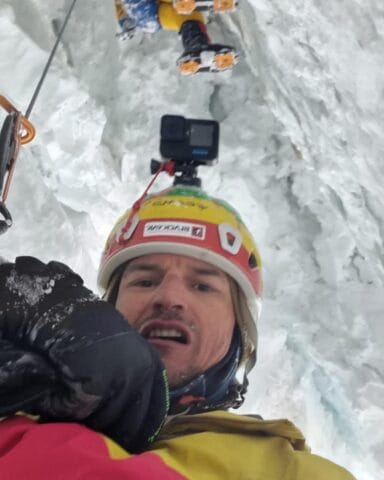 Brazilian climber Moeses Fiamoncini and Maloo’s Sherpa were nearby, watching him rappel down a short twenty-five-foot ice cliff when he rappelled off the end of a short rope. Assumedly he used the wrong rope by mistake. After falling off the end of the rope, he tumbled uncontrollably down the steep icy slope into the crevasse. Fiamoncini saw him fall in and called out to him, but there was no response. Eventually, they had to leave as the weather worsened, and they were in an area that had avalanched two weeks earlier. ExplorersWeb posted several videos taken by Fiamoncini after the fall.
Brazilian climber Moeses Fiamoncini and Maloo’s Sherpa were nearby, watching him rappel down a short twenty-five-foot ice cliff when he rappelled off the end of a short rope. Assumedly he used the wrong rope by mistake. After falling off the end of the rope, he tumbled uncontrollably down the steep icy slope into the crevasse. Fiamoncini saw him fall in and called out to him, but there was no response. Eventually, they had to leave as the weather worsened, and they were in an area that had avalanched two weeks earlier. ExplorersWeb posted several videos taken by Fiamoncini after the fall.
Maloo has now been transferred to a hospital in the Indian city of Manipal.
The individuals involved in the rescue included:
Chhang Dawa Sherpa (Ground Handling) @14dawa
Adam Bielecki @adamtheclimber
Mariusz Hatala
Lakpa Nurbu Sherpa
Chhepal Sherpa
Dawa Nurbu Sherpa
Lakpa Sherpa
Tashi Sherpa
Pilot Sobit Gauchan
Nepal Army
APF
helicopter pilot Gauchan
Mingma Sherpa and Chhang Dawa Sherpa posted these videos and pictures:
Another Indian climber, Baljeet Kaur, climbing with Nepali operator Pioneer, was missing after her no O’s summit. For unknown reasons, she was alone and became lost. However, a helicopter search found her alive at 24,000 feet, and she was rescued by long line to safety.
On Dhaulagiri, where there are thirty foreigners, most with Seven Summits treks, porter Amrit Rai is missing after an avalanche struck him and others as they were leaving base camp, according to a report in the Himalayan Times. Carlos Soria, 84, is on the peak attempting it for the 14th time.
Over on Makalu, Pioneer Adventures reports that Camp 2 has been established.
And in the department of uniformed moves, Mt Everest Today noted that American Darren Verploegen, 37, from Montana, USA, was seen and bragged about paragliding from Camp II to EBC on Everest. Officials at base camp turned him in. Nepal requires a special permit before any type of flight or even skiing. Mr. Verploegen said that he was unaware one was needed. He may be banned from returning to Nepal if found guilty. He was with Seven Summits Treks.
Everest: Rotations Begin, Record Permits
With their puja completed, several teams, having completed their skills review near EBC, are now as high as Camp 2, around 21,00 feet, for their first rotation. Teams include Madison Mountaineering and Climbing the Seven Summits. I’m sure there are many more with forty teams on the mountain.
The rope fixing team from Imagine Nepal, Dawa Gyalje, Pasang Temba Sherpa, Lakpa Sherpa, Phinjo Dorjee Sherpa, Ngima Dorjee Tamang, Pema Chhiri Sherpa, Dipen Gurung, Lakpa Tenjing Sherpa, Ngima Nuru Sherpa and Pasang Nima Sherpa, got the fixed ropes to the South Col on Saturday, April 23, 2023. I expect them to reach the summit late next week. This is about the same time as in previous years.
As of April 23, the Ministry of Tourism has issued a record 454 permits for Everest, with 18% female climbers. There are eighty for Lhotse. I expect around 450 for Everest. The previous record on the Nepal side was 408 in 2021. The top three countries on Everest, as expected, are China at ninety-six, the US at eighty-seven, and India at forty. For all of Nepal’s mountains, there are currently 1,005 permits issued.
Next Week
More teams will arrive at EBC. As I discussed before, it’s becoming more common to arrive after mid-May due to acclimating at home or on other nearby trekking peaks to reduce the trips through the Icefall.
On Shishapangma, look for a summit attempt by Norwegian Kristin Harila, Mexican Viridiana Alvarez, and French-Swiss Sophie Lavaud. They are supported by six Sherpas.
If you’re curious about Kami Rita Sherpa, who has the record for Everest summits at 26, he’s climbing again this season. He is guiding Tony Schiena, Chief Executive Officer at Multi Operational Security Agency Intelligence Company, using logistics from 14 Peaks. He’ll probably get his 27th summit.
I’ve reported on several Everest climbers with disabilities, so let me add another to the list. Shawn Cheshire, an Army Veteran and three-time paracycling National Champion, is on Everest. She is blind and wants to get both E and Lhotse.
Unique
In the unique department, not everyone climbs all fourteen 8000ers; some are content to trek to their base camps. Trevor Builder (Australia) and Emma Huffam (New Zealand/Australia) did their first trek in 2013 to Everest Base Camp as part of celebrations of the 60th Anniversary of the first ascent of Mt Everest. So it’s fitting that in 2023, the year of the 70th Anniversary, they completed their project.
They completed their project in several phases involving trips to Nepal (to trek to the base camps of Everest, Kanchenjunga, Lhotse, Makalu, Dhaulagiri, Manaslu, Annapurna), Pakistan (for K2, Nanga Parbat, Gasherbrum I, Broad Peak, Gasherbrum II) and Tibet (Cho Oyu and Shishapangma).
Kind of fun! You can read all about their adventure on their website.
With teams now going higher, let’s look at their first steps:
First Steps in the Icefall
Anxiety
You set your alarm for 3:30 am knowing it was unnecessary as you’ve been awake with anticipation for the last two hours. Over last night’s dinner, the guides announced that today would be the first climb into the Icefall. Immediately, your anxiety level ratcheted up a notch. The Khumbu Icefall. You have seen so many pictures, a few videos and recently studied it from Kala Patar, Camp 1 on Pumori, and your base camp tent. But now it was time for the real thing.
You sit up in your sleeping bag and push the squishy headlamp-on button. The bright light shows your clothes laid out on the tent floor. You did that before going to sleep. Slowly, everything feels slow now; you pull on your climbing clothes. This is just a trip halfway up to the Football Field, but it still requires warm layers, gloves, boots, crampons, harness, jumar, cow’s tail, ice axe–the works. The three-person tent that seemed so big when you arrived now seems like a closet as you swing your legs off the mattress and pull on your pants. Your arms hit the sides as your top layer slides on. The moisture that built up through the night on the tent ceiling falls gently on your head. “Well, I guess that’s my morning shower.” You say to yourself.
Scooting to the door, you pull your boots into the tent, cursing at not having the foresight to keep them inside so they wouldn’t freeze. Now you would pay the price with ten minutes of close combat–you against your boots. Yet another lesson on high-altitude climbing. Finally, dressed for action, you stumble outside your tent only to trip over a guy line. “Damn, and I’m going to climb Everest?” you mutter to yourself. Standing in the cold, crisp air, you pause. Looking around, you see your teammates performing the same circus act.
Can’t Eat
Glancing at the Icefall, you see a string of headlamps softly glowing in the dark night; um, someone is already up there. Probably Sherpas carrying a load to Camp 1 or Camp 2. You hear the low hiss of stoves as the cooks are making breakfast. Once again, you send a thought of gratitude for how hard the cook team works, getting up so early to send the Sherpas out with a full stomach, and now the team members. It is cold, but you are not cold. Looking at your yellow 8000-meter boots, the contrast against the snow is vibrant. Without thinking, a smile grows on your face. You are about to enter the Icefall.
The Sherpas gather by the cook tent, eating Tsampa, an unidentifiable concoction of rice, milk, and sugar. They eat with the enthusiasm of a starving teenager. You walk over and enter the dining tent, seeing the cooks have already brought out toast and a boiled egg for each climber. You spread some jam on your toast and stare at the egg. A teammate pushes some coffee your way. A grunt is all you can muster.
Go!
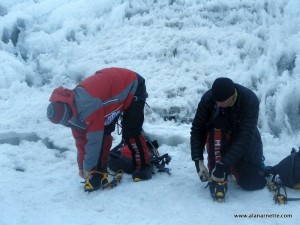
Without warning, the Sherpas enter the tent, calling out names. Not sure if you are being summoned or punished, you stand up quickly and follow your personal Sherpa, Dawa. You walk together to the puja altar, where the sweet smell of burning juniper fills the air.
Dawa approaches the smoke. He bows his head and then raises his right arm with an open palm. He smoothly swipes at the smoke, bringing it toward his face. He repeats the movement two more times as he asks for safe passage for himself and everyone on Everest today. Understanding the meaning, you follow his lead.
Dawa sets a brisk pace through the maze of paths in base camp. Switching on your headlamp, you follow closely, still unsure of the correct turns to make. Crampon Point is your destination. With the finesse of a lightweight boxer, Dawa bobs and weaves between the tents. He dodges a yak standing on the trail, careful not to touch the sleeping beast.
You soon reach the perimeter of base camp and take a step onto a flattish section of the Icefall. You were here a few days ago to run through your gear on the obstacle course, but this time, it is for real. The route becomes circuitous now, up and down small ice hills, stepping over small sections of running water, maneuvering around growing ponds. Careful not to get your boots wet, you take big steps while Dawa seemingly floats over them.
Doubts
Your breathing increases. Tiny drops of sweat form on your chest, your forehead. The doubts begin again. “Oh my God, if I’m struggling just to get to Crampon Point, what will …” You stop yourself, remembering the value of mental toughness.
You and Dawa arrive at Crampon Point with the energy of an Indy race car coming into the pit for a tire change. Taking your crampons out of your pack, you kneel on one knee to attach the spikes to your oversize boots. Right, then left; thread the safety strap around your ankle and through the ring; double back the strap. You’re done. Dawa looks at your work, inspecting it. Feeling like a child, you look yourself to make sure you put them on the correct foot; buckles go outside for safety. You look up at Dawa, but he has already moved on.
Struggles
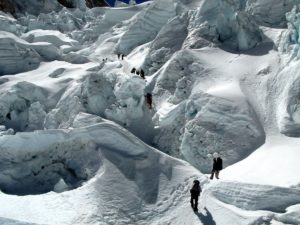
The first few steps into the Icefall proper are steep. “Who put the route over a 30-foot ice bump at the start?” you mumble. Your breathing picks back up. Dawa’s headlamp seems like a searchlight, not looking ahead but side to side, using the eyes in the back of his head to see if you are keeping up. He slows down a bit.
Reaching the beginning of the fixed line, you take the carabiner attached to a piece of webbing that is attached to your harness and clip in. You will repeat this act several hundred, if not thousands, of times over the next few weeks. Seeing more people ahead, you silently mouth a plea, hoping the crowd ahead will slow down your Super Sherpa.
Moving steadily, you gain altitude in the Icefall. The wee hours of the morning are cold; it is dark; there is no moon tonight. Maybe for summit night? The Sherpas often say a full moon is an auspicious sign. Headlamps show the way, but so do the line of climbers ahead of you and the thin white nylon line, another part of climbing Everest you will get to know.
Soon the conga line comes to a halt. Actually, it’s just you and Dawa because Dawa has no patience for slow climbers, and he passed each of them, pulling you along in his slipstream. While you struggle to breathe, you know this is a good sign, as he will get you to the summit and not let anyone or anything slow you down.
Ladders
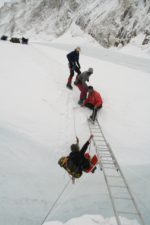
Bent over with your hands on your hips, you struggle to catch your breath. Finally, you look up. The emerging sunlight shows the reason for the sudden stop–a ladder. A ladder? A ladder! Suddenly, your mind becomes focused. No more idle thoughts, no more complaining, no more breathing. You are staring at a single ladder stretched across a crevasse. In the dawn light, you cannot see how deep it is. Just as well.
Dawa looks at you as you take a second carabiner off your harness. He goes first. Clipping in both ‘biners to the two safety ropes on either side of the ladder, he steps onto the first rung, then the second, and without so much as a pause, he is across, standing there staring at you. You can almost hear him in a deep John Wayne voice, “OK, kid, I showed you how to do it. Now get on with it.”
You lean over and grab the safety line, left one first. Clipping in, you feel secure, then the right, now more secure. Moving your right boot off the snow, your front crampon points touch the first metal rung. A metallic clink supplies feedback. Your left foot follows but goes to the second rung. You are on the ladder. Now it is time to move.
Breathe
The death grip on the safety line hurts your fingers even through your thick gloves. Your right foot inches forward, not too high off the ladder. You make a sudden decision to take it one rung at a time, not two or three like Dawa. Your front points make a successful landing.
You feel good and proud of your baby step, but then everything changes. Feeling panic, you sense something is wrong. You stop with your right foot ahead and the left behind. You look ahead at Dawa; then it occurs to you—breathe.
Climb On!
Alan
Memories are Everything
The Podcast on alanarnette.com
You can hear #everest2022 podcasts on Spotify, Apple Podcast, Google Podcasts, Pocket Casts, RadioPublic, Anchor, and more. Just search for “alan arnette” on your favorite podcast platform.
Why this coverage?
I like to use these weekend updates to remind my readers that I’m just one person who loves climbing. With 37 serious climbing expeditions, including four Everest trips under my belt and a summit in 2011, I use my site to share those experiences, demystify Everest each year and bring awareness to Alzheimer’s Disease. My mom, Ida Arnette, died from this disease in 2009, as have four of my aunts. It was a heartbreaking experience that I want no one to go through; thus, I ask for donations to non-profits where 100% goes to them, and nothing ever to me.
![]()

Summit Coach
If you dream of climbing mountains but are not sure how to start or reach your next level, from a Colorado 14er to Rainier, Everest, or even K2, we can help. Summit Coach is a consulting service that helps aspiring climbers throughout the world achieve their goals through a personalized set of consulting services based on Alan Arnette’s 25 years of high-altitude mountain experience, including summits of Everest, K2, and Manaslu, and 30 years as a business executive.

